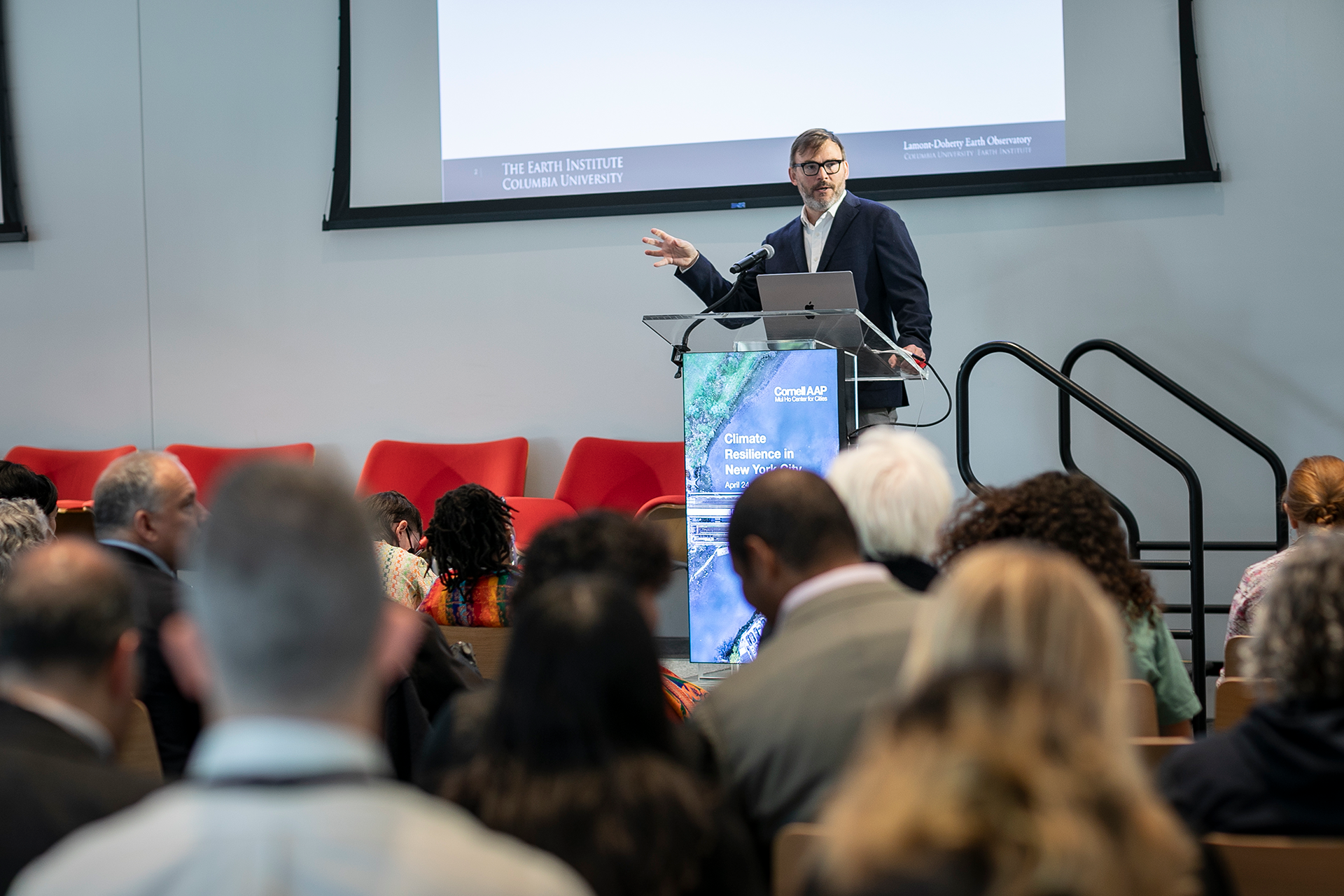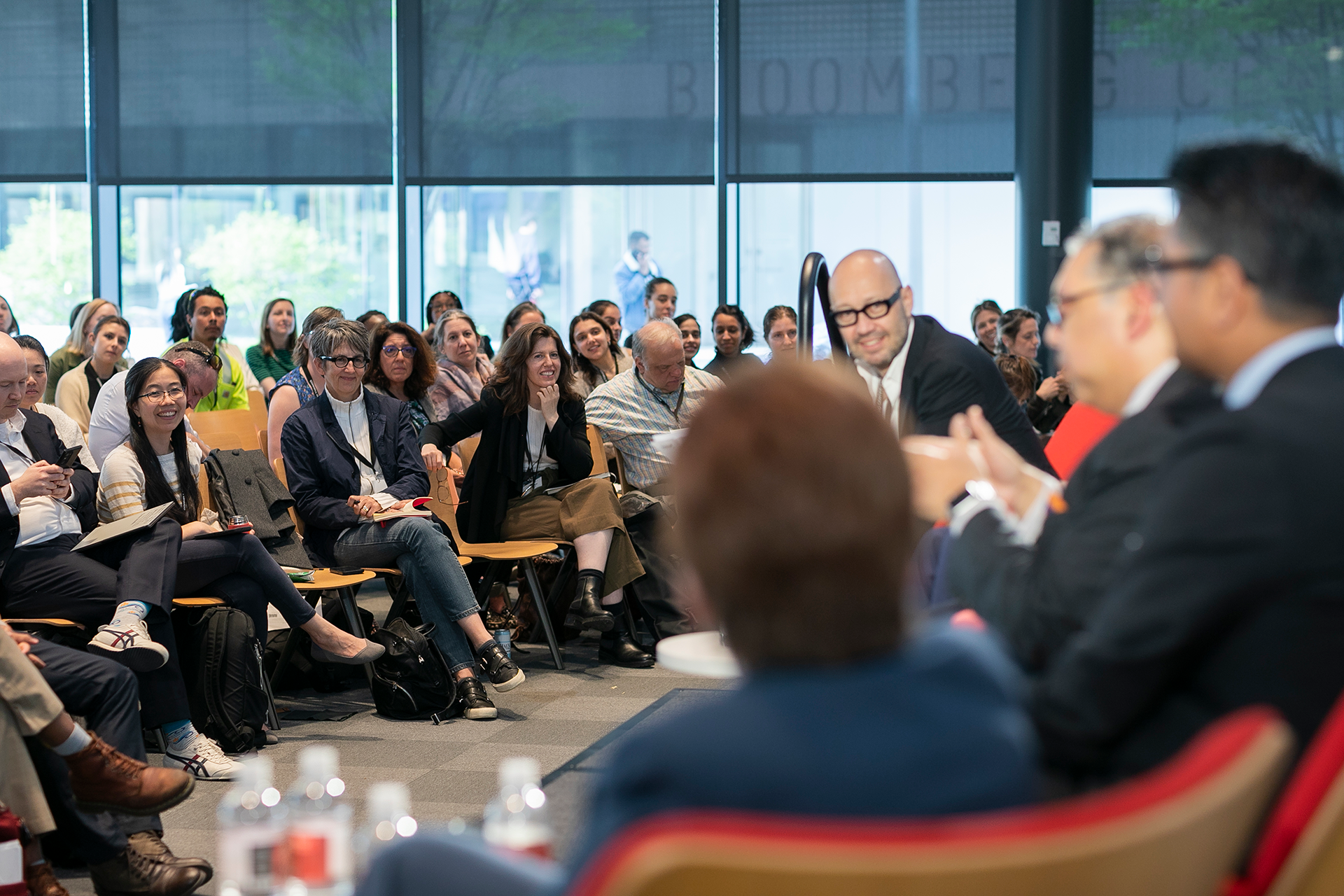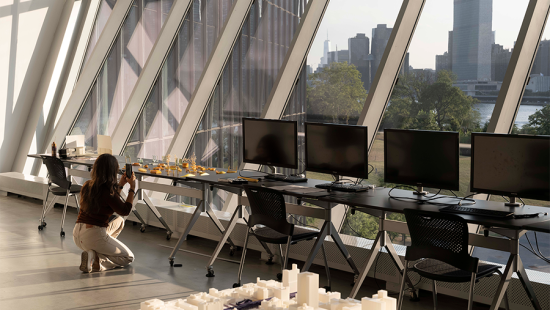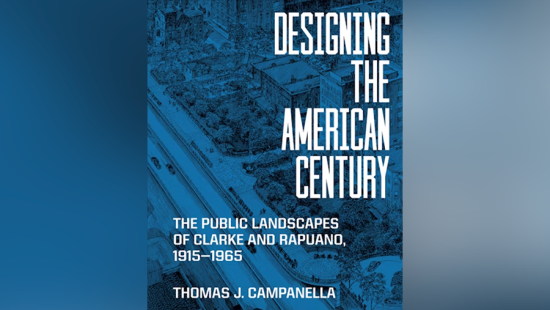From Knowledge to Climate Action in New York City
A symposium hosted by the Cornell Mui Ho Center for Cities brought together experts from across fields to address the hazards facing the city and consider actions to mitigate risks to people, buildings, and infrastructure.

Radley Horton, Professor of Climate, Columbia University, gives the keynote speech "The Science of Urban Climate Change in New York City." image / Jesse Winter
New York City is the largest urban center in America, an economic and cultural powerhouse, and well positioned to be a leader on climate action and innovation. It is also a deeply unequal city with a long history of environmental injustices, and a coastal city exposed to severe and growing climate hazards.
All this makes it an ideal city for Cornell students and researchers seeking to make a difference for urban climate resilience. Since its launch in 2022, the Cornell Mui Ho Center for Cities has worked closely with academic, government, civil society, and private sector partners to study key climate challenges in New York City and support efforts to build resilience, particularly in highly vulnerable communities.
On April 24, the Center for Cities brought together 260 scientists, public officials, local advocates, industry leaders, architects, planners, and urban designers to take stock of New York City's biggest climate challenges, barriers to action, and innovative and impactful solutions.
"Almost everyone in this room is actively working on issues that intersect with urban climate change, but from different perspectives," said Victoria A. Beard, Professor of City and Regional Planning and Director of the Center for Cities, at the start of the symposium, held on the Cornell Tech campus on Roosevelt Island. "Given the current political environment, this opportunity to convene has never felt more precious than it does in this moment."
Government agencies and scientists who gather and analyze climate data are losing their funding, Beard noted, and so are social scientists investigating the forces that create and reinforce patterns of urban inequality and environmental injustice. At the same time, "there is a sense of urgency" to understand climate risks, engage with the most affected people, and tackle historical legacies of inequality and injustice. "And there is urgency on the part of universities to fulfill their mandate to produce knowledge that can be applied and make cities more resilient and livable for all residents."
The Science: Three Climate Trajectories
The program began with a keynote address by Radley M. Horton, Professor of Climate at Columbia University and a member of the New York City Panel on Climate Change (NPCC), which since 2009 has synthesized new scientific research on climate change to inform policy and planning in the city.
We can still, through our actions, lead to a more just society, and improve many things beyond climate risk. — Radley M. Horton
If observed trends in rainfall, temperatures, and sea-level rise continue, Horton said, "we'll see a profound increase in the frequency, intensity, and duration of extreme weather events." Moreover, communities are vulnerable "in a very nonlinear way," with some people disproportionately affected due to factors such as poverty and age. A heatwave that is 1°C hotter can lead to sharp increase in deaths in some communities, and a downpour that's 5% stronger than the last may cause not just minor flooding, but a disaster, depending on the neighborhood you live in.
Yet a continuation of observed trends is "probably a best-case scenario," Horton warned. There is growing evidence that the climate is changing faster than expected, likely due to unaccounted-for interconnections and cascading impacts. In that scenario, the severity of the risks is increasingly uncertain.
"The prospects of extreme climate change and extreme impacts have grown much worse," Horton said. But there is a third, more hopeful climate storyline: We have more innovative solutions than ever before, and key technologies are more affordable. Cities like New York have also embraced justice-based approaches that, if scaled up, could help ensure that even the most vulnerable can adapt effectively.
"We are the people who can help prevent the worst outcomes," he said. "We can still, through our actions, lead to a more just society, and improve many things beyond climate risk."

Members of the audience listen and take notes. image / Jesse Winter
Tracking Flood Risks and Adapting Legacy Infrastructure
Next came a panel discussion on flood risks, moderated by Timon McPhearson, Professor of Ecology, Director of the Urban Systems Lab at The New School, and a key partner in the Center for Cities' work in the city. He began by asking Alan Cohn, Senior Policy & Science Advisor at the NYC Department of Environmental Protection (DEP): "What's happening now that's working?"
Cohn, whose agency manages both stormwater and wastewater for the city, said utilities across the country have been tackling challenges together through the Water Utility Climate Alliance, and he's particularly optimistic about nature-based solutions. Many of the places that flood today were historically wetlands, he noted, and layering green infrastructure over the sewer system can help mitigate flood risks.
McPhearson noted that the city has created thousands of rain gardens since adopting its Stormwater Resiliency Plan in 2021. Cohn added that the city has learned by doing, adapting the designs to integrate vegetated areas with, say, a basketball court that can flood. "So I'd say it's going well," he said, "but our work is cut out for us… this is going to be decades and decades. It's really about reshaping the city."
Jeanne DuPont, Executive Director of RISE, a nonprofit in the Far Rockaways that organizes residents to fight for environmental justice, highlighted another bright spot: engaged young people. RISE, a community partner in the Center for Cities' NYC resilience work, brings in high school students as interns and teaches them to analyze data from FloodNet sensors in the area.
The teenagers have proven to be deeply knowledgeable about risks in their neighborhood, DuPont said, and many have become effective advocates in public forums. "It opens our eyes to the value of their knowledge, what they can bring to the table, no matter how young or old," she said. Many are also pursuing careers in science, urban planning, and other fields where they can make a difference.
Energy Poverty as a Barrier to Heat Resilience
The second panel discussion, moderated by New York Times international climate reporter Somini Sengupta, focused on extreme heat. For New Yorkers, climate change is only part of the challenge; densely built-up areas with little vegetation and poor airflow also create an intense urban heat island effect, and many people live in poorly insulated and energy-inefficient buildings that absorb and retain heat.
Peggy M. Shepard, Executive Director of WE ACT for Environmental Justice, said "very little" is working well in NYC when it comes to heat resilience. Black New Yorkers are disproportionately affected by extreme heat, less than half of public housing residents have air conditioning, and many public cooling centers are closed in the evenings and on weekends, Shepard said.
Laura Bozzi, Director of the NYC Department of Health and Mental Hygiene and Director of Programs for the Yale Center on Climate Change and Health, said the city's annual heat mortality report shows people are dying in their homes from extreme heat, and while cooling centers help, not everyone can access them.
"We've really pushed hard, based on our data, to increase protections at home," Bozzi said. Just as landlords are required to keep buildings at a safe temperature in the winter, the City Council is considering legislation to set a maximum safe temperature for the summer. Still, she noted, it is not enough to install AC, because "you may have an air conditioner, but not be able to pay to run it."
Panelists agreed that energy efficiency upgrades, more affordable electricity, and protection from power shutoffs are all important for heat resilience. The power grid itself will also need major upgrades, both to handle the increased demand during hot days, and to ensure the equipment can withstand the heat.

Symposium participants discuss energy insecurity and extreme heat during a breakout session. image / Jesse Winter
Will NYC Have Enough Water in the Future?
A third panel, moderated by Adam Freed, Principal at Bloomberg Associates and member of NYC's Water Board, focused on a less widely discussed, but also crucial climate risk for the city: drought.
New York has "one of the most extraordinary water systems in the world," he said, delivering over 1 billion gallons every day through 6,000 miles of pipes. "It is an engineering and environmental marvel that defines our city's health, our economy and our growth." Yet the water system is "under threats and risks like we've never imagined before," he added.
The good news, Freed said, is that there are solutions: from restoring watersheds, to modernizing pipes and treatment plants to be more efficient, to reducing water consumption. Jerry Mead, Chief of Modeling and Analysis at the NYC DEP, also highlighted technological advances that provide crucial data on water supply and demand, identify outages, and predict shortages — though the models still need to improve.
Other panelists noted the importance of collaboration across jurisdictions since watersheds stretch across state lines, and the value of community engagement, including citizen science to help monitor and protect watersheds. "We can't be everywhere monitoring everything — we need help," said Novem Auyeung, Director of Research and Monitoring at the NYC Department of Parks and Recreation.
Hands-On Tools for Building Resilience
Four simultaneous, interactive breakout sessions in the afternoon provided opportunities for every participant to dig into data related to climate change and/or environmental justice in New York City and discuss how it could be put to use in planning inclusive solutions and building community resilience.
- The Mayor's Office of Climate and Environmental Justice hosted a session on the EJNYC mapping tool, which maps heat and flood vulnerability as well as air pollution, housing quality, and other issues relevant to climate resilience.
- The NYC Department of Health invited participants to use its health data portal to examine exposure to extreme heat together with energy insecurity.
- The Mayor's Office of Management and Budget explained how the City has integrated climate into the municipal budgeting process, and invited participants to consider how they might budget for resilience.
- The US Forest Service presented the Stewardship Mapping Project (STEW-MAP), which has identified local communities and organizations that are engaged in environmental stewardship, and will be updated in 2027.

Jose Castillo, Professor and Chair of the Department of Architecture, moderates the Mayor’s Panel. image / Jesse Winter
The Power of Local Leadership
The final panel of the day focused on the crucial role of local elected officials in driving urban climate action. Jose Castillo, Professor and Chair of Architecture at Cornell, led a conversation with Mayor Kathy Sheehan, of Albany, New York; Mayor Michael Cahill, of Beverly, Massachusetts; Mayor Aftab Pureval, of Cincinnati, Ohio; Mayor Quinton Lucas, of Kansas City, Missouri; and Naheed Nenshi, former mayor of Calgary, Canada.
A key takeaway was that to be effective champions of climate actions, mayors need to turn complex challenges into simple, relatable messages that resonate locally. As Nenshi put it, it's "bringing up the values that people really are about: This is about your kids. This is about the future. This is about a clean river that we can all enjoy. I think that's an important piece to get beyond the current divisiveness in politics."
The mayors also stressed the importance of seizing opportunities for action without delay to avoid losing momentum, and of delivering tangible results that directly benefit people.
For more information about the symposium, the panelists, and the tools presented, and links to additional materials, visit the event listing.







